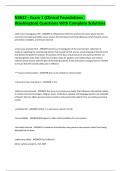N3632 - Exam 1 (Clinical Foundations -
Washington) Questions With Complete Solutions
.(Fall scene investigation) FSI - ANSWER-A collaborative effort to examine the scene where the fall
occurred and explore possible causes using a documentation tool that addresses safety hazards, future
prevention strategies, and lessons learned
.(root cause analysis) RCA - ANSWER-Involves an investigation of the environment, collection of
evidence regarding the contributing factors that caused the fall, and an actual drawing of the fall scene
that details the patient's location, the position of the bed, and presence of any assistive devices. An
interdisciplinary team then revisits the incident, looks for patterns and relationships, and reviews
systems and processes with the goal of identifying patients at risk and system changes that are needed
to ensure that the revised safety plan is effective
.***visual communication - ANSWER-the use of symbols to communicate
.A pressure ulcer may form in - ANSWER-1-2 hr
.ability to communicate - ANSWER-The nurse must assess any factor that influences the patient's ability
to receive and send messages. Fatigue, stress, medication, aphasia, and language barriers are examples
of factors that can affect personal communication and prevent the patient from accurately perceiving
events
.accidental fall - ANSWER-clutter or a spill cause a person to trip
.Accountability - ANSWER-Willingness to take credit and blame for ones actions.
.Activated charcoal - ANSWER-A substance that absorbs many poisons and prevents them from being
absorbed by the body
.adolescent safety - ANSWER-Peer influence
Motor vehicle accidents- DUI, DWI
,Binge drinking
Alcohol use more common
Distracted driving- talking, texting, eating, self grooming
Nurse+Parents collaboration for teaching
Substance abuse-OTC, prescribed, street drugs
Tobacco
Body Piercing-very risky
Tattoos- viruses and bacteria
Guns- higher than any other age group, high suicide
Internet- offenders reach out to vulnerable adolescents, cyberbullying
.adults - ANSWER-Stress-coping, unsafe health habits (drugs)
Domestic Violence- (IPV) rape, physical/sexual violence, stalking-- child abuse?
Abuse Assessment Screen - specific protocol
Safety plan (escape)
place to stay
escape route
person to call
important paperwork
bank account and money
packed bag of clothes
.Advocacy in Nursing Practice - ANSWER--Representaiton of pts "speak up" for pt
-Promoting self determination facilitating a pts individual right to make a decision
.Advocays - ANSWER-support of pts health, wellness, safety, and personal rights including privacy
.Aerobic - ANSWER-Require oxygen
,.Aggressive behavior - ANSWER-involves asserting one's rights in a negative manner that violates the
rights of others
-can be verbal or physical
-communication is marked by tension and anger inhibiting the formation of good relationships and
collaboration
-characteristics include using an angry tone of voice, making accusations, and demonstrating
belligerence and intolerance
-focus is usually *winning at all costs*
.Airborne Precautions - ANSWER--tb, varicella (chicken pox), rubeola (measles), severe acute resp
syndrome (SARS)
-private rm, neg air pressure, door closed
-surg mask on pt w/ transport
-PPE + resp protection (N95)
-negative pressure
.Alcohol-based hand rub (ABHR) - ANSWER--refers to a 60-95% ethanol or isopropyl (types of alcohol)
-1-3 mL for 15 seconds+
-containing preparation designed for application to the hands to reduce microorganisms
Used:
-before direct contact with pt
-after direct contact with pt
-after contact with body fluids, mucus mem, non-intact skin, and wound dressings, *if hands are not
visibly soiled*
-after removing gloves
-Before inserting a urinary catheter, IV, or invasive devices that do not require surgical placment
-Before donning sterile gloves before an invasive procedure
, -If moving from a contaminated body site to a clean body site during pt care
-after contact with objects in pts environment
.alopecia - ANSWER-hair loss or baldness
.Alturism - ANSWER-concern for the welfare and well-being of others
-demonstrates understanding of cultures, beliefs, and perspectives of others
-Advocates for patients, particularly the most vunderable
-Takes risks on behalf of patients and colleagues
-Mentors other professionals
.ANA Standards- RN - ANSWER--Use code of ethics to guide practice
-deliver care in a maner that preserves and protects
-promotes pt centered care
-upholds health care consumer confidentiality
-assists pt in self determination and informed decision making
-therapeutic relationship with pt
-be able to resolve ethical issues
-take action reguarding illegal, unethical, or inappropriate
-speaks up when appropriate
-advocate for equitable pt care
.Anaerobic - ANSWER-Process that does not require oxygen
.anthrax - ANSWER-Symptoms variable based on form of anthrax:
Cutaneous: skin lesion with local edema that progresses, enlarges, ulcerates, and becomes necrotic
Gastrointestinal: nausea, vomiting, fever, abdominal pain, hematemesis, severe diarrhea




